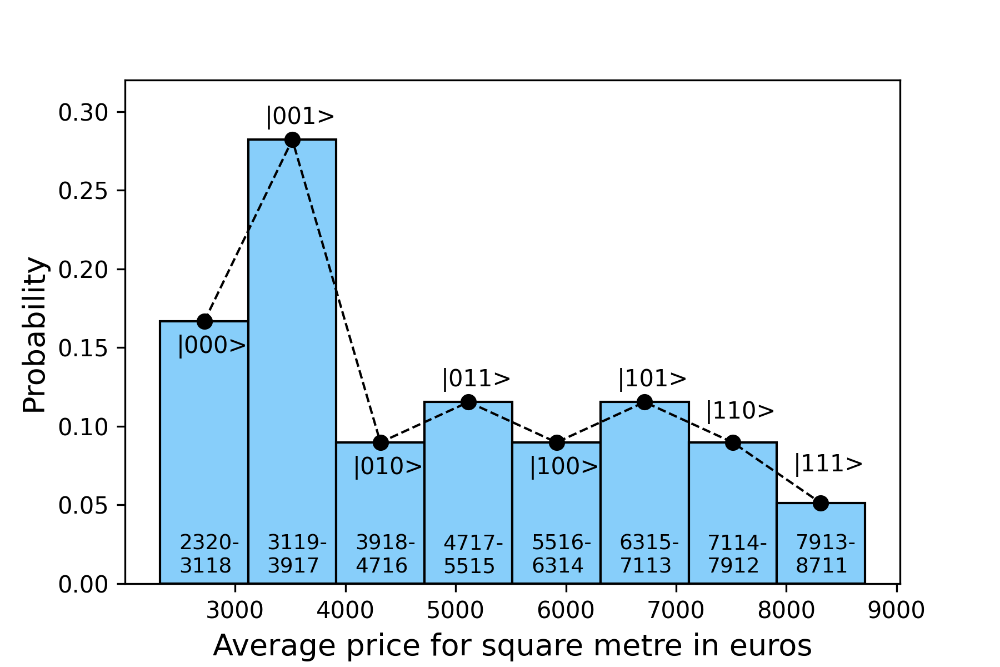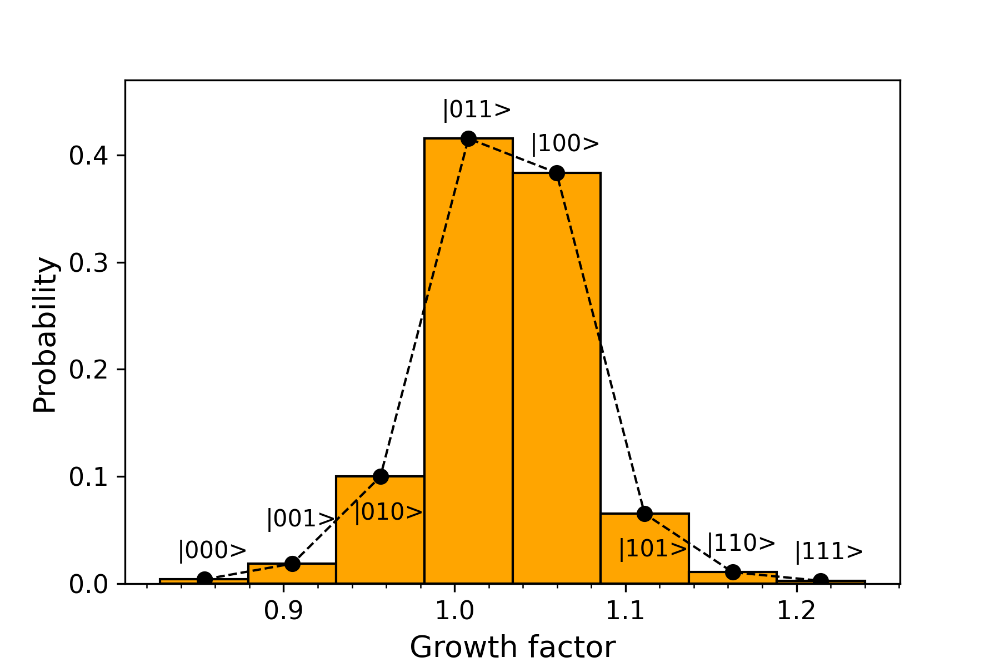The housing market’s quantum future
Quantum computers are hitting the world with a bang. Qubits, the turbo-charged quantum cousins of regular bits, are revolutionising computational research and modelling, including and especially in the financial sector. Could quantum algorithms be used in the future to forecast trends in home prices more accurately, for example? OP Financial Group’s innovation unit OP Lab and CSC set out to investigate this possibility.
Since the 1980s, quantum computers have come from a concept in the minds of a few scientists to real-world applications that are expected to revolutionise the way we solve computationally complex tasks. Already, quantum computers have solved calculations that go beyond the abilities of even the most powerful supercomputers. Hundreds of millions of euros are invested in the technology every year, and the pace is only increasing. While quantum computers show a great deal of promise, much work is still needed to make them truly viable. One of the end goals of quantum computing is to make tasks which are at present unsolvable due to their computational complexity. Potential uses for this are found in many areas of research. The case of the financial sector is particularly interesting as complex mathematical models are a significant part of business.
A hot topic in the field of quantum computing is quantum advantage. This refers to the ability to solve a problem more efficiently than classical computing, usually in terms of speed. This requires the use of sufficiently advanced quantum computers. The basic unit of information in a quantum computer is the quantum bit or qubit. Whereas the classic binary bit can receive the values one or zero, a qubit is significantly more versatile and can, in a way, describe any value in between these. The number of qubits indicates the quantum computer’s computing power. Unlike with classic bits, adding just one qubit can, in principle, double the computing power! However, qubits are highly susceptible to disturbances and information stored in them can be lost in an instant. Our current quantum computers are composed of no more than a hundred qubits. Already, some highly interesting calculations are possible, but in order for quantum computing to make a true breakthrough, computers need to become larger and more reliable.
CSC and OP Lab began the collaboration with the aim to investigate how computational challenges in the financial sector and promises offered by quantum technology are connected now and in the future. The financial sector places challenges on the capabilities of classical computing in areas such as simulations, optimisation, and machine learning. Quantum solutions have been developed for each of these. In simulations, for example, computing power is required for pricing financial instruments and carrying out risk analyses, while optimisation looks for the most profitable portfolio or arbitrage strategy. Versatile machine learning models are also in high demand in the financial sector.
Quantum solutions are based on quantum algorithms – multi-layered instructions used to operate the quantum computer. Quantum algorithms can be designed, tested, and refined using quantum computer emulators. In addition to classical supercomputers, CSC’s services include the Atos QLM, familiarly known as Kvasi, one of the world’s most advanced development environments for quantum algorithms. In this project, Kvasi was applied to solve problems found in the real world.
Quantum algorithm for forecasting home price trends
Quantum computing differs from a normal computer enormously, and the easiest way to approach the concept is often through a concrete example. For this purpose, a suitable application for quantum computing had to be identified from calculations done at OP. The test case selected for the project was OP’s machine learning model for forecasting home prices. The model is used to provide price estimates for homes based on completed sales and other details of the listed home.
Instead of machine learning, the quantum solution selected was Monte Carlo simulation, which is a commonly used tool in the financial sector, including housing market forecasts. The Monte Carlo method has attracted a great deal of attention among developers of quantum algorithms. As early as in 2000, a theory was developed for a method that performs simulations in just the square root of the time required by a classical supercomputer: when the simulation’s level of detail is increased to a depth that would require a hundredfold increase in solving time for a classic model, the quantum calculation takes just ten times longer. As a result, quantum simulations can achieve unprecedented accuracy in their forecasts.
The problem tackled in the project was forecasting average prices per square metre of homes in Helsinki in 2021. The source data used was publicly available data by Statistics Finland on average prices per square metre from 2010 to 2020 in nearly all postcodes in the city. In the most simple model, prices for the next year were predicted using just two variables: the price in the year before and the annual rate of growth, depicted as probability distributions. The first distribution was simulated by dividing prices in each postcode as a histogram. In the second distribution, an annual growth rate was calculated for each area and placed in a similar histogram. The probability distributions were divided into eight values, as shown in Figure 1. Attentive readers will notice the crudeness of the outlined problem, but more on that later.


The quantum algorithm consisted of three building blocks. First, the probability distributions depicting the variables were fed into the algorithm. This was simple as probabilities and the states inhabited by qubits go hand in hand. The eight values in the distributions can be described using three qubits (23 = 8). In the histograms, these states are described in binary numbers. Binary numbers can be set to describe the values of the original variables. Next, some quantum-mechanical calculation must be performed based on the distributions. In this case, the variables were multiplied together. The third step is evaluating the calculation’s outcome. This method requires a great deal of low-level programming and management of quantum states, which is typical for quantum algorithms in use today.
Of course, our problem in the project is fairly simple, and the solution is easily calculated using classical methods. Based on available data, the average price per square metre in 2021 is €5,009. The answer given by our quantum algorithm was €4,977. The errors are mainly due to approximations made when designing the algorithm. As is typical in quantum mechanics, performing the quantum calculation always involves some degree of uncertainty, and the correct result is given only with some probability. Despite its simplicity, the quantum solution worked wonderfully!
What did we learn from the project? Firstly, in terms of calculation time, truly useful quantum computing is still some way away in the future. Still, algorithms and true quantum computers are developing at a stunning speed. Not too far in the future, problems like the one above can be solved using true quantum phenomena. After this, the next step is expanding the algorithm to sizes that leave classical computing methods in thedust. At this stage, the complexity of the problem must also be increased. This is unlikely to be difficult as the task of appraising the value of a home and its development is a complicated one! The formula used to determine the price could easily accommodate other variables, such as the number of rooms and need for repairs, each of which would form its own probability distribution. The distributions could also be depicted in greater resolution, which would pose an even bigger challenge to classical methods. As noted above, with quantum computers, doubling resolution requires adding just one more qubit. In addition, such a quantum-mechanical calculation could involve more complexities than simply multiplying the variables together. In principle, this could be applied to almost anything!
A look at what’s ahead
Today’s quantum computing could be compared to the task of programming classical computers using punchcards. Despite this, we are all aware how the development of computer technology over the past 50 years has permanently transformed our world. Quantum computing is constantly developing, and the first evidence of true quantum advantage is likely to speed up the pace of development even further. Indeed, the industry around quantum computing is expected to grow exponentially. With strong expertise in high-end technology, Finland stands to benefit from this growth, also in international comparisons. The growth company IQM and VTT Technical Research Centre of Finland are currently designing a Finnish quantum computer, around which a strong, Finnish quantum infrastructure is forming. In this development, Finnish businesses, along with a – hopefully – large pool of potential end customers, play a significant role.
Practical quantum computing is coming, but the question is when? Estimates range from five years to decades, and no-one knows the right answer for certain. In contrast, the answer to the most pressing question is known: how can we prepare for this? It is important to keep track of technological trends and build expertise in quantum computing within the organisation. In particular, in the financial sector, businesses must identify how quantum computing will impact their processes and take the necessary measures. At the very least, it is worth keeping active track of technological development in the company’s internal workgroups or in collaboration with partners in the quantum computing industry. When the quantum revolution comes, those well prepared will reap the greatest benefits and competitive edge.
Tangible next steps
Quantum programs used for this work, and related ones, in the form of Jupyter Notebooks, are found on CSC’s Github. They can be run and edited with Kvasi.
Otto Salmenkivi
The author was a trainee at the CSC and is now heading back to his physics studies to eagerly await the arrival of the quantum revolution.
Email: otto.salmenkivi@gmail.com or LinkedIn: www.linkedin.com/in/ottosalmenkivi
Mikael Johansson
The author explores, ponders, and enables quantum technologies at CSC.
Petri Liimatta
The author explores new technologies and their potential applications in the OP Group
Juha Vesanto
Juha Vesanto, PhD in Technology, develops and commercialises intelligent machine learning applications at OP Group
